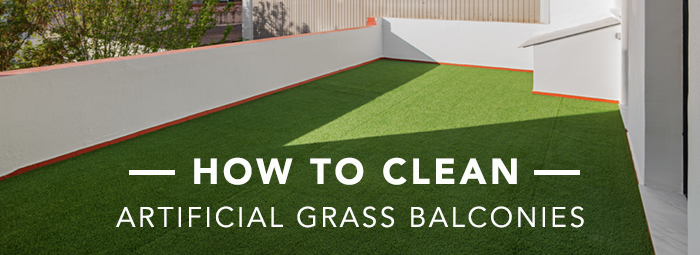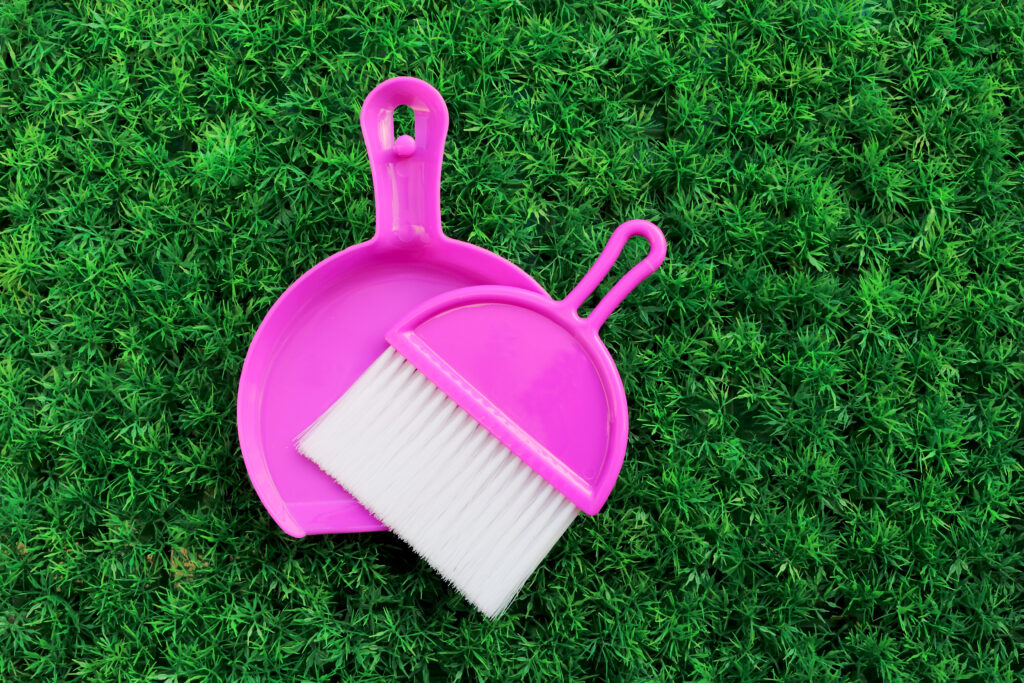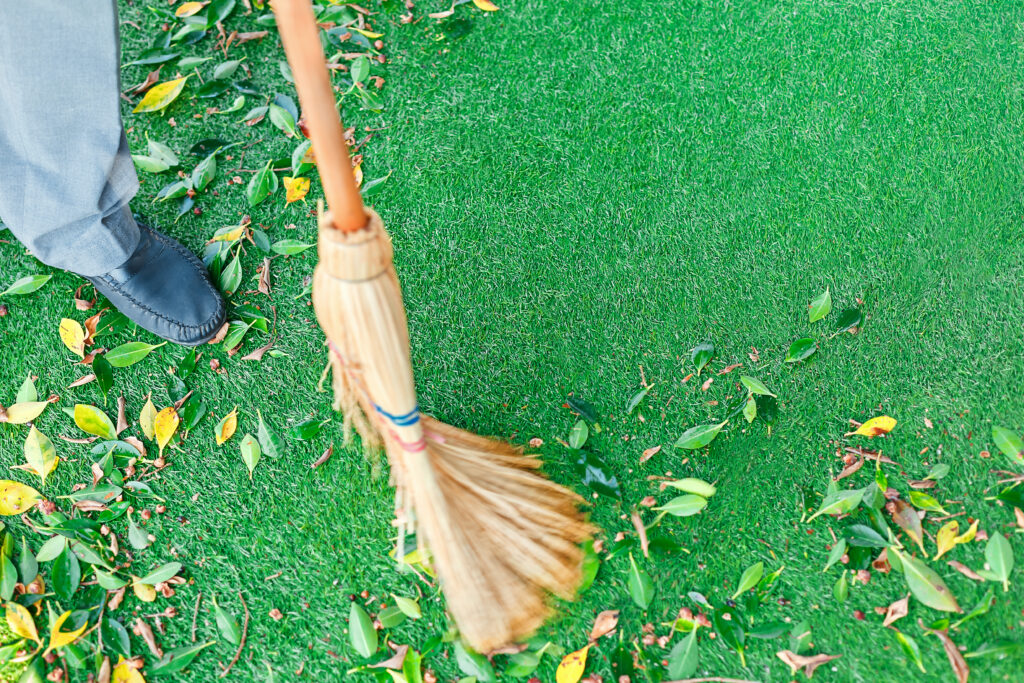
Originally posted on July 19, 2021
Have you ever enjoyed a great time on your turf-covered balcony only to notice some unpleasant spills afterward? **Taking care of your synthetic grass** is essential for maintaining a neat space, including your balcony. Luckily, we’re specialists in high-quality turf and we’re ready to share our secrets on keeping your green area spotless. Whether it’s a balcony or [deck](https://turffactorydirect.com/2021/02/08/can-you-turf-a-wood-deck/), we have some strategies to ensure you can relax in your clean, green oasis for years to come. Why stick around? Because we’re about to reveal some uncommon tips that’ll prevent your artificial grass from becoming a real nuisance!
Balcony Turf Needs Cleaning Too
Artificial turf is extremely low maintenance and doesn’t require much attention. Most artificial grass only needs to be cleaned once a week or biweekly, just to ensure that dust and debris don’t accumulate, and if you give it a little spritz every other week, larger cleanings are required far less often.
Artificial turf is stain-resistant by design, so you shouldn’t need to worry too much about that either. Basically, periodically remove debris and give the whole thing a cleaning and you’re squared away.
Assemble the Tools for Cleaning Turf
Cleaning artificial turf on your balcony is a similar process to cleaning both indoor turf and turf lawns. Here’s some tools that are handy to have nearby when you’re cleaning artificial turf:
- Rake or air blower (blower for larger surfaces)
- Stiff broom or brush that is non-metallic
- Hose, bucket, and/or spray bottle
- DIY cleaning solution of equal parts water and vinegar or soapy water, or a commercial turf cleaning solution
- Paper towels

Incident Cleaning on Turf
Accidents happen. If you have a one-off dirtying incident, the steps are pretty simple for handling the incident. Cleaning up any spills as they happen with a DIY or commercial cleaner is easy:
- Rinse the area with water
- After that, spray the space with a mild soapy solution, or a mixture of water and vinegar in equal parts, and rinse again with water.
- Finally, pat dry and air dry.
If you have an intense spill or stain, make sure that you try to blot it with paper towels or towels first, and then clean away the stains with a mix of detergent and water.
Spot an old stain on your turf?
Spills and accidents happen when we’re not looking, and it can be a real surprise when you find them hours, days, or even weeks after the fact. If spills and messes go unnoticed and are left for an extended period of time this can be more difficult to remove. Some substances can be trickier to remove, like blood, coffee, or wine. Turf is stain-resistant, but it’s important for sanitation to clean up those spots.
- In a bucket, mix a mild detergent such as dish soap with water.
- Spray with a solution of equal parts water and vinegar or a commercial turf cleaner.
- Use a sponge or soft cloth to rub it onto the spot until it’s removed.
- Rinse and repeat as needed.
- Pat dry and air dry.
Got a sticky residue too tough for water?
If the stain is really persistent, use a toothbrush. If you have a sticky problem, putty knives are an excellent tool for removing the offending area, or apply ice to it to freeze it and remove it.
Regular Cleaning for Turf
Dust, leaves, and dirt can build up on your turf surface. In order to prevent these buildups from occurring, spray your turf every week. Keep in mind that you might need to do so more often if you live in a dry, dusty area.
For a heavier buildup, such as piles of leaves in fall or dirt from storms, rake or brush it off. Use a stiff brush that does not have steel bristles or a lawn rake that is flexible in order to avoid damaging your turf. Artificial grass fibers, while resilient, can be damaged by pressure washers. Avoid using them. A regular garden hose will do the trick just fine to rinse down the turf.
If you’ve got pets, scheduling regular weekly cleaning is essential. If your pet is regularly heading out to do their business on the artificial grass, make sure to scoop the poop when it’s convenient, and try not to let it sit for too long. Urine will be absorbed and drained away with rain, but if your pets are using the same spot, it can become a hotbed for bacteria.
You can fix this by washing the yard down regularly, or getting a mixture of vinegar and water for a quick spray down. Scoop and dispose of the matter, then spray the area with a hose. For urine, spray the affected areas with a hose and consider using turf deodorizer, or artificial grass enzyme cleaner or antimicrobial turf cleaner.

Periodic Cleaning for Turf
Constant transit on artificial turf can result in certain areas being crushed and losing their natural aesthetics. Therefore, it’s convenient to perform periodic maintenance and cleaning. Periodically brush and occasionally wet down the entire surface to clean it.
Use grooming equipment that is safe for artificial turf. Normally, you can use a broom or handled brush as long as they aren’t too harsh on the turf blades. Brush it lightly every three to four weeks to keep the blades standing upright.
Blood, pet waste, and other substances can leave bacteria behind on your artificial turf. To remove it, wash it with a mix of vinegar and water or mild soap and water. Use a spray bottle for smaller areas and a garden hose attachment for larger areas.
Removing Snow & Ice from Turf
Depending on where you live, snow and ice can accumulate on exposed balconies and even covered balconies. Removing snow and ice helps keep your artificial turf from becoming slippery. Most of the time, you can wait for snow and ice to melt and drain on its own. If you need to clear it off before that, brush off light coverings of snow. If you have a lot of snow, shovel the top layers, then brush off the remaining snow to protect the blades from damage.
Can you vacuum artificial grass?
You can vacuum non-infill turf with a regular vacuum cleaner. While this type of turf is mostly used indoors, occasionally you’ll find it outside and on balconies. However, repeated vacuuming can cause the turf to become torn or slumped over time.
You can also vacuum turf with infill, but you risk removing the infill which keeps the turf looking springy and also provides cushioning. Be mindful that this method can severely clog and potentially jam some vacuums, so be careful.
Does turf need a professional cleaning service?
While hiring a cleaning service is an option, you’ll most likely only ever need to hire one in the most extreme of cases. Regular turf cleaning and maintenance is a totally DIY option.
Commercial vs. DIY Cleaning Products
There are a couple options for cleaning solutions when you’re getting ready to clean turf.
Commercial Cleaners
Enzyme cleaners are almost always the way to go, and ones that have antimicrobial cleansers in them as well will make sure that the turf is both deodorized and clean.
Here are a few recommendations for commercial turf cleaners:
- BioTurf – This concentrated enzyme cleaner will take any type of odor or microbes to the cleaners.
- Simple Green – Another enzyme cleaner that’s non-toxic and pet safe.
DIY Cleaners
The most reliable anti-odor and antimicrobial solution you can make for yourself at home is a mixture of one-half vinegar and one-half water. Simple as that.
Turf Factory Direct is your Turf Expert
By following maintenance and grooming procedures on a regular basis, you can ensure that your artificial turf balcony lasts for years and stays in excellent condition for you to enjoy. Whether you’re in need of turf for your roof, lawn, playground, or gym Turf Factory Direct has you covered. We’re here to help, so get in touch with us or start browsing our products today.







